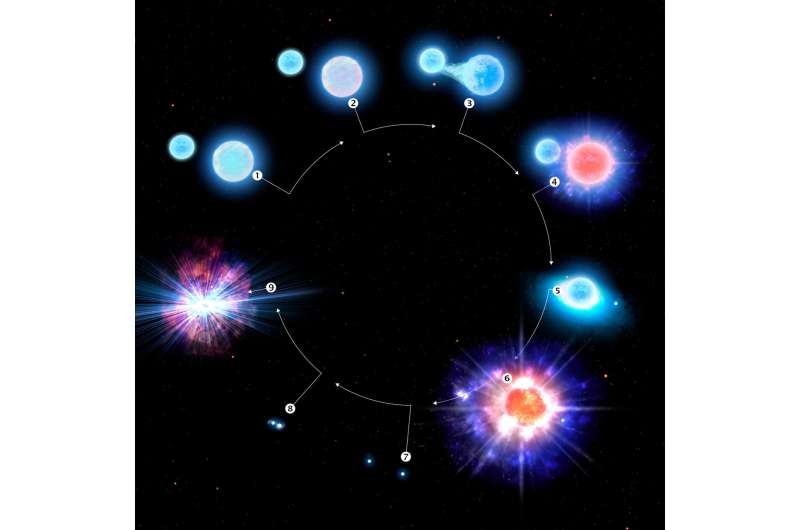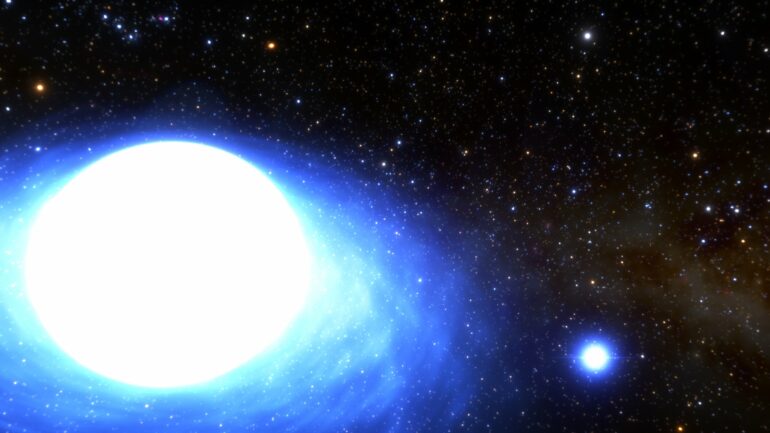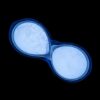After crunching a mountain of astronomy data, Clarissa Pavao, an undergraduate at Embry-Riddle Aeronautical University’s Prescott, Arizona campus, submitted her preliminary analysis. Her mentor’s response was swift and in all-caps: “THERE’S AN ORBIT!” he wrote.
That was when Pavao, a senior space physics major, realized she was about to become a part of something big—a paper in the journal Nature that describes a rare binary star system with uncommon features.
The paper, published on Feb. 1, 2023, and co-authored with Dr. Noel D. Richardson, assistant professor of Physics and Astronomy at Embry-Riddle, describes a twin-star system that is luminous with X-rays and high in mass. Featuring a weirdly circular orbit—an oddity among binaries—the twin system seems to have formed when an exploding star or supernova fizzled out without the usual bang, similar to a dud firecracker.
The binary’s round orbit was a key clue that helped researchers identify the second star in the binary system as a depleted or “ultra-stripped” supernova. Usually, after a star consumes all of its nuclear fuel, its core collapses before exploding into space as a supernova. In this case, Richardson said, “The star was so depleted that the explosion didn’t even have enough energy to kick the orbit into the more typical elliptical shape seen in similar binaries.”
We are stardust
The binary system’s name sounds like a license plate: CPD-29 2176. Researchers estimate that there are probably only about 10 such star systems in the galaxy at present. By studying it, they are unraveling new clues to our earliest beginnings, as stardust.

This infographic illustrates the evolution of the star system CPD-29 2176, the first confirmed kilonova progenitor. Stage 1, two massive blue stars form in a binary star system. Stage 2, the larger of the two stars nears the end of its life. Stage 3, the smaller of the two stars siphons off material from its larger, more mature companion, stripping it of much of its outer atmosphere. Stage 4, the larger star forms an ultra-stripped supernova, the end-of-life explosion of a star with less of a “kick” than a more normal supernova. Stage 5, as currently observed by astronomers, the resulting neutron star from the earlier supernova begins to siphon off material from its companion, turning the tables on the binary pair. Stage 7, with the loss of much of its outer atmosphere, the companion star also undergoes an ultra-stripped supernova. This stage will happen in about one million years. Stage 7, a pair of neutron stars in close mutual orbit now remain where once there were two massive stars. Stage 8, the two neutron stars spiral into toward each other, giving up their orbital energy as faint gravitational radiation. Stage 9, the final stage of this system as both neutron stars collide, producing a powerful kilonova, the cosmic factory of heavy elements in our Universe. © CTIO/NOIRLab/NSF/AURA/P. Marenfeld
“When we look at these objects, we’re looking backward through time,” explained Pavao. “We get to know more about the origins of the universe, which will tell us where our solar system is headed. As humans, we started out with the same elements as these stars.”
Richardson added that, without binary systems like CPD-29 2176, life on Earth would be very different. “Systems like this are likely to evolve into binary neutron stars, which eventually merge and form heavy elements that get hurled into the universe,” he noted. “Those heavy elements allow us to live the way that we do. For example, most gold was created by stars similar to the supernova relic or neutron star in the binary system that we studied. Astronomy deepens our understanding of the world and our place in it.”
Persistence pays
The project started when Pavao stopped by Richardson’s office in hopes of scoring a research experience. “I said, ‘Please give me any research.'” He happened to have data, captured by the Cerro Tololo Interamerican Observatory’s 1.5 meter telescope in Chile, from a bright star known as a Be-type star. The Be star was located at the same location on the sky as another one that had produced a large flash of X-rays. That flash—possibly something called a “soft gamma repeater”—had gotten astronomers’ attention, prompting Richardson and others to request telescope data.
Pavao plotted the spectra of the Be star, but first, she had to clean up the data so they were less noisy. “The telescope looks at a star and it takes in all the light so that you can see the elements that make up this star,” she noted, “but Be stars tend to have disks of matter around them. It’s hard to see directly through all that stuff.”
Persistence paid off: Pavao managed to learn more about data processing and computer coding so that she could analyze the stellar spectra. She and Richardson found one simple line that came from the star and wasn’t influenced by the disk around it. She thought her graph was a scatterplot. Richardson thought otherwise, prompting his all-caps email. After quickly fitting Pavao’s data into a special computer program, he realized they had found an orbit for the star, but it was different than expected. Further data-crunching revealed that one star was indeed tracing a circle around the other one every 60 days or so.
Pavao recalls Richardson saying, “This is not just a simple binary system.”
Collaboration counts
Enter Jan J. Eldridge of the University of Auckland, a co-author on the Nature paper and a foremost expert on understanding binary star systems and their evolution. At Richardson’s request, Eldridge reviewed thousands of binary star models and found only two that were analogous to the one that he and Pavao were studying.
Eldridge and colleagues then diagramed the life cycle of the two binary system stars, explaining how the supernova relic had puffed up and dumped mass onto the Be star until it began to build up, too. Ultimately, the supernova became a low-mass helium star that exploded, leaving behind a neutron star, but it had already transferred so much of its mass to the Be star that the explosion was lackluster.
“Basically, we found out how the ultra-stripped supernova interacts with the Be star, and how it goes through these weird life-cycle phases,” Pavao explained. “At some point in the future, that Be star will also be a supernova neutron star as the cycle continues. It will become a binary system with two neutron stars, millions of years from now.”
More information:
Noel Richardson, A high-mass X-ray binary descended from an ultra-stripped supernova, Nature (2023). DOI: 10.1038/s41586-022-05618-9. www.nature.com/articles/s41586-022-05618-9
Provided by
Embry-Riddle Aeronautical University
Citation:
When your supernova’s a dud: Rare binary star features weirdly round orbit, researchers report (2023, February 1)



